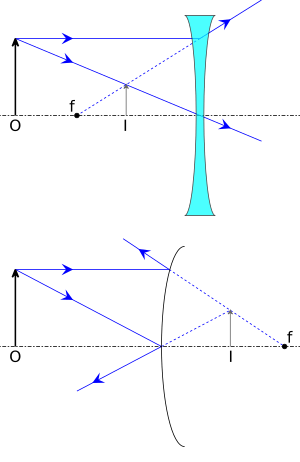Virtual image facts for kids

In the study of optics, which is about how light behaves, a virtual image is a special kind of image. It forms when light rays coming from an object always spread out, or diverge, after hitting a mirror or going through a lens. Think about looking into a flat mirror at home. The image of yourself you see behind the mirror is a virtual image. The light from you only exists in front of the mirror, but your reflection appears to be just as far behind the mirror as you are in front of it.
Contents
What is a Virtual Image?
A virtual image is a picture of an object that appears to be in a certain place, but the light rays don't actually meet there. It's like a trick of light! Because the light rays never truly come together at the image's location, you cannot catch or project a virtual image onto a screen.
How is a Virtual Image Formed?
Virtual images are created by different optical tools.
Plane Mirrors
The simplest example is a flat, or plane, mirror. When you look into a plane mirror, your reflection seems to be inside the mirror. The light rays from your body hit the mirror and bounce off. Your brain then traces these bounced rays back in a straight line, making it seem like the light is coming from behind the mirror. This is why the image appears to be behind the mirror, even though no light actually goes there.
Diverging Lenses and Convex Mirrors
Virtual images can also be formed by lenses that spread light out (called diverging lenses) or by mirrors that curve outwards (called convex mirrors). These tools make light rays diverge even more. When you look through a diverging lens or into a convex mirror, objects often look smaller and closer than they really are. The image you see is a virtual image because the light rays only appear to come from that spot; they don't actually meet there.
Virtual vs. Real Images
It's helpful to compare virtual images with real images.
Real Images
A real image is different because it forms when light rays from an object actually meet and come together at a specific spot. Imagine a movie projector. It shines light through a film, and the light rays converge to form a clear picture on the screen. That picture is a real image. Because the light rays truly meet, a real image can be projected onto a screen or captured on photographic film.
Key Differences
- Virtual Image: Light rays spread out (diverge) and only appear to come from the image location. You cannot project it onto a screen.
- Real Image: Light rays actually meet (converge) at the image location. You can project it onto a screen.
See also
 In Spanish: Imagen virtual para niños
In Spanish: Imagen virtual para niños

